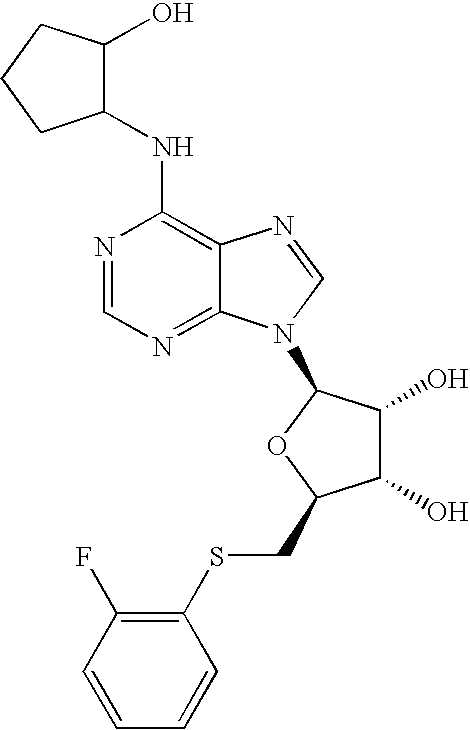Partial and full agonists of A1 adenosine receptors
a technology of adenosine receptor and partial agonist, which is applied in the field of compounds, can solve the problems of short-lived effects, increased likelihood of ventricular arrhythmias, and short-lived effects, and achieve the effect of prolonging the effect of action
- Summary
- Abstract
- Description
- Claims
- Application Information
AI Technical Summary
Benefits of technology
Problems solved by technology
Method used
Image
Examples
example 2
Preparation of a Compound of Formula (3)
A. Preparation of a Compound of Formula (3) in which R2 is Hydrogen, R3 is 2-Fluorophenyl, and X is a Covalent Bond
To a solution of 6-(6-chloropurine-9-yl)-2,2-dimethyltetrahydrofuro[3,4-d][1,3]dioxol-4-yl]methanol, a compound of formula (2) (0.48 g, 1.47 mmoles) in 20 mL of tetrahydrofuran was added triphenylphosphine (0.77 g, 2.94 mmoles) and diethylazodicarboxylate (0.47 mL, 2.94 mmoles), and the mixture stirred for 5 minutes. 2-Fluorothiophenol (0.31 mL, 2.94 mmoles) was then added, and the mixture was stirred under reflux. After 72 hours of reflux, the reaction was concentrated in vacuo and the residue purified by flash column chromatography (20% EtOAc / Hexanes) to give 1-{[(2S,1R,4R,5R)-4-(6-chloropurin-9-yl)-7,7-dimethyl-3,6,8-trioxabicyclo[3.3.0]oct-2-yl]methylthio}-2-fluorobenzene, a compound of formula (3), as a clear viscous oil (3). (0.25 g, ˜40%)
1H NMR (CDCl3) δ 1.4 (s, 3H), 1.6 (s, 3H), 3.2 (m, 2H), 4.6 (t, 1H), 5.1 (m, 1H),...
example 3
Preparation of a Compound of Formula (4)
A. Preparation of a Compound of Formula (4) in which R is Hydrogen, R1 is Cyclopentyl, R2 is Hydrogen, R3 is 2-Fluorophenyl, and X and Y are Covalent Bonds
To a solution of 1-{[(2S,1R,4R,5R)-4-(6-chloropurin-9-yl)-7,7-dimethyl-3,6,8-trioxabicyclo[3.3.0]oct-2-yl]methylthio}-2-fluorobenzene, a compound of formula (3), (0.125 g, 2.86 mmoles) in 10 mL of ethanol and 1 mL of triethylamine was added cyclopentylamine in excess, and the mixture refluxed under nitrogen for 24 hours. The solvent was removed under reduced pressure, and the residue was purified by preparative TLC using 1:1 EtOAc:Hexanes to give (9-{(4S,1R,2R,5R)-4-[(2-fluorophenylthio)methyl]-7,7-dimethyl-3,6,8-trioxabicyclo[3.3.0]oct-2-yl}purin-6-yl)cyclopentylamine, a compound of formula (4), as a yellow oil (80 mg, 56%)
1H NMR (CDCl3) δ 1.4 (s, 3H), 1.6 (s, 3H), 1.6-2.4 (m, 6H), 3.15-3.25 (m, 2H), 4.1 (bs, 1H), 4.4 (t, 1H), 5.1 (m, 1H), 5.5 (m, 1H), 6.0 (d, 1H), 6.2 (bs, 1H), 7.0 (...
example 4
Preparation of a Compound of Formula I
A. Preparation of a Compound of Formula I in which R is Hydrogen, R1 is Cyclopentyl, R2 is Hydrogen, R3 is 2-Fluorophenyl, and X and Y are Covalent Bonds
(9-{(4S,1R,2R,5R)-4-[(2-fluorophenylthio)methyl]-7,7-dimethyl-3,6,8-trioxabicyclo[3.3.0]oct-2-yl}purin-6-yl)cyclopentylamine, a compound of formula (4) (50 mg) was dissolved in a mixture of acetic acid (8 mL) and water (2 mL) and heated at 90 C for 16 hours. Solvents were removed under reduced pressure, and the residue was purified by preparative TLC [methanol-dichloromethane(1:9)] to afford (4S,5S,3R)-2-[6-(cyclopentylamino)purin-9-yl]-5-[(2-fluorophenylthio)methyl]oxolane-3,4-diol, a compound of Formula I.
1H NMR (CDCl3) δ 1.6-2.4 (m, 6H), 3.15-3.25 (m, 2H), 4.1 (bs, 1H), 4.4-4.65 (m, 4H), 6.0 (d, 1H), 6.8 (bs, 1H), 7.05 (m, 2H), 7.2 (m, 1H), 7.4 (m, 1H), 7.8 (s, 1H), 8.25 (s, 1H).
B. Preparation of a Compound of Formula I, Varying R1
Similarly, following the procedure of 4A above, but ...
PUM
| Property | Measurement | Unit |
|---|---|---|
| covalent | aaaaa | aaaaa |
| action potential | aaaaa | aaaaa |
| resistance | aaaaa | aaaaa |
Abstract
Description
Claims
Application Information
 Login to View More
Login to View More - R&D
- Intellectual Property
- Life Sciences
- Materials
- Tech Scout
- Unparalleled Data Quality
- Higher Quality Content
- 60% Fewer Hallucinations
Browse by: Latest US Patents, China's latest patents, Technical Efficacy Thesaurus, Application Domain, Technology Topic, Popular Technical Reports.
© 2025 PatSnap. All rights reserved.Legal|Privacy policy|Modern Slavery Act Transparency Statement|Sitemap|About US| Contact US: help@patsnap.com



